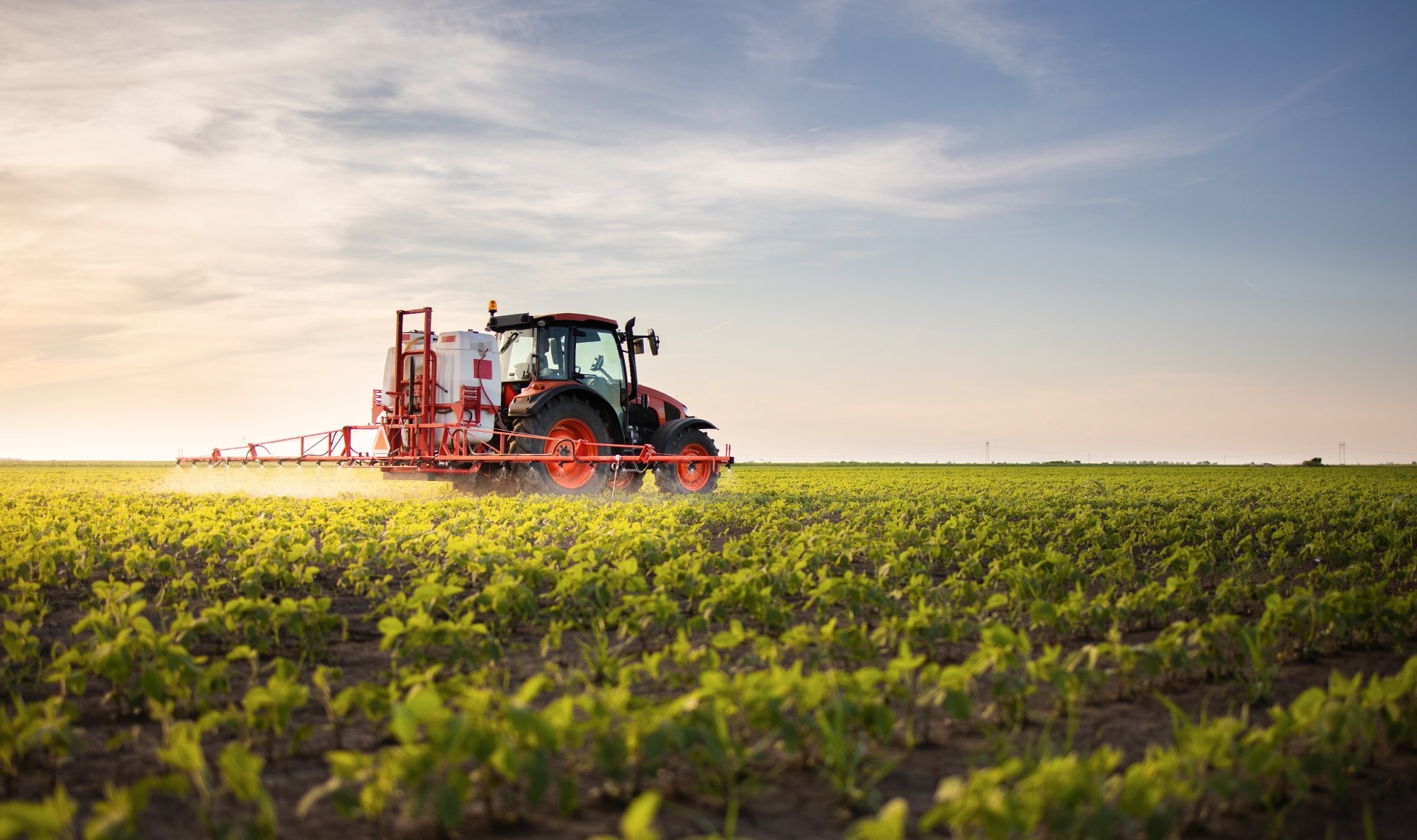 By Owais AliReviewed by Lexie CornerUpdated on Aug 15 2024
By Owais AliReviewed by Lexie CornerUpdated on Aug 15 2024Around 800 million people globally face food shortages, and the excessive use of traditional agricultural inputs has led to environmental degradation and reduced soil quality.1 Nanotechnology presents an opportunity to revolutionize agriculture by enhancing resource efficiency, boosting crop yields, and minimizing environmental impact through innovations in seed coatings, precision farming, and food processing.
 Image Credit: Fotokostic/Shutterstock.com
Image Credit: Fotokostic/Shutterstock.com
Nanotechnology: An Overview
Nanotechnology involves the science and engineering of manipulating matter at the nanoscale (1–100 nm). At this scale, materials exhibit unique chemical, physical, and biological properties that differ significantly from their bulk counterparts.
Nanomaterials can be fabricated via top-down (reducing larger structures to nanoscale) or bottom-up (assembling from atoms/molecules) approaches using techniques like vapor deposition, laser ablation, and nano-imprinting.2
Nanotechnology's Impact on Agriculture Industry
Nanotechnology offers transformative benefits for agriculture, particularly in enhancing crop protection, nutrient delivery, and soil management. It addresses key challenges such as soil degradation and food scarcity by using nanoparticles to improve stress tolerance, reduce oxidative damage, and enhance nutrient use efficiency.
For instance, silver nanoparticles and nano-enzymes help mitigate stress and improve crop growth, while nanoscale carriers (such as nanoscale clay nanotubes) optimize the delivery of fertilizers and pesticides, reducing environmental impact.
Additionally, nanotechnology offers sustainable alternatives to conventional practices and promotes precision farming, early pathogen detection, and high-yield productivity.2,3
Applications in Agriculture
Enhancing Plant Growth and Protection
Nanotechnology enhances plant growth and protection through nano biofortification, where nanoparticles such as fullerol improve plant biomass, fruit size, and yield. This approach enriches plants with essential nutrients to address malnutrition and increase resilience.
These methods can be integrated with autonomous sensors and GPS systems to efficiently monitor crop growth and soil conditions, enabling precise application of nano-nutrients for optimal crop improvement.3
Disease and Pest Management
Nanotechnology is transforming pest and disease management in agriculture through the development of nano agrochemicals, such as nano herbicides (e.g., atrazine in poly(ε-caprolactone)), nano fungicides (e.g., copper nanoparticles), and nanoemulsions (e.g., β-cypermethrin). These innovations offer targeted release and increased efficacy while minimizing environmental impact.
Additionally, nano biosensors using gold nanoparticles, quantum dots, and carbon nanotubes enable precise pathogen detection. Nano barcode technology further supports multiplexed pathogen identification, enhancing early disease diagnosis and promoting sustainable agricultural practices.3,4
Seed Nano-Priming
Seed nano-priming uses nanoparticles to enhance seed germination and growth, surpassing traditional methods. For instance, chickpea seeds treated with iron, zinc, and calcium nanoparticles show increased weight and yield, offering a promising approach to improving agricultural productivity.5
Genetic Engineering and Gene Editing
Nanotechnology has enhanced traditional gene transfer techniques, such as electroporation and Agrobacterium-mediated transfer. Gold nanoparticles and carbon nanotubes are now effectively used for gene delivery in crops like tobacco and rice.
Additionally, integrating nanotechnology with CRISPR/Cas9 systems has advanced genome editing by enabling precise genetic modifications, such as enhancing disease resistance in wheat, leading to more robust and productive agricultural outcomes.6
Smart Fertilizers
Nano or smart fertilizers encapsulate nutrients in nanomaterials for controlled and targeted release, improving efficiency and reducing environmental impact compared to traditional fertilizers.
These include formulations with chitosan, silicon dioxide, and carbon nanotubes, which improve germination rates, nutrient uptake, and crop yields. This technology is also utilized in space and underwater farming, where zeolite-based fertilizers support plant growth in microgravity and controlled environments.
Food Packaging and Preservation
Polymer nanocomposites (PNCs) containing clay, silica, and silver enhance food freshness, shelf life, and safety. In addition, smart packaging systems equipped with nanosensors detect spoilage and contamination, while nano-encapsulated ingredients improve food quality and nutrition.
Various companies are developing smart packaging systems using nano clay composites. For example, Bayer's Durethan® KU2-2601 is used for beverage packaging, while flexible films like Plantic® Plastic Tray are commonly employed for packaging Cadbury® Dairy Milk™ and Mark & Spencer Swiss Chocolate.3,7
Recent Developments and Innovations
Plant Virus-Based Nanoparticles for Targeted Nematode Control
Researchers at UC San Diego developed plant virus-based nanoparticles for targeted pesticide delivery deep into the soil, offering a new approach to control crop-damaging nematodes (roundworms). The results are published in Nano Letters.
This innovation targets parasitic nematodes in crop root zones using pesticide-loaded nanoparticles derived from a modified, noninfectious tobacco mild green mosaic virus. It reduces pesticide use and environmental impact by effectively delivering pesticides 10 centimeters into the soil while preserving the pesticide's chemical structure, thereby avoiding the need for new regulatory approvals. This approach has been shown to reduce nematode populations by at least 50 %.
"This technology holds the promise of enhancing treatment effectiveness in the field without the need to increase pesticide dosage," said Steinmetz, the study's senior author.8
Enhancing Crop Growth with Iron Oxide Nanoparticles
Iron (Fe) is essential for plant growth and development, but its availability is often limited in high-pH and aerobic soils, leading to deficiencies in crops such as peanuts. Traditional Fe-rich fertilizers—whether chelated, organic, or inorganic—have limitations, such as high cost, susceptibility to adsorption, or ineffectiveness in alkaline soils.
Research published in Frontiers in Plant Science explored the use of iron oxide nanoparticles (Fe2O3 NPs) as an alternative to traditional iron fertilizers to address Fe deficiencies in crops like peanuts.
The study found that Fe2O3 NPs improved peanut growth, chlorophyll content, and Fe efficiency, potentially outperforming traditional Fe sources like EDTA-Fe. In addition, these nanoparticles also reduced oxidative stress by modulating reactive oxygen species (ROS) and plant hormone levels while adhering to soil particles to minimize nutrient loss and enhance fertilizer efficiency in sandy, nutrient-poor soils.9
Real-Time Plant Hormone and Stress Monitoring with Nanotube Sensors
The Temasek Life Sciences Laboratory and Singapore-MIT Alliance for Research and Technology (SMART) researchers developed novel nanosensors capable of distinguishing and detecting gibberellins (GAs), crucial plant hormones. These non-destructive sensors utilize near-infrared fluorescent carbon nanotubes to offer real-time monitoring of GA levels in living plants, providing an early indicator of plant stress, such as salinity. The results are published in Nano Letters.
Unlike traditional destructive methods like mass spectrometry, these nanosensors are more efficient and selective and can be applied across various plant species. This breakthrough could revolutionize precision agriculture, enabling early intervention and optimized crop management.
The researchers also designed a new coupled Raman/near-infrared fluorimeter to enhance the sensors' accuracy, making the technology more practical for field applications.
"In the near future, our sensors can be combined with low-cost electronics, portable optodes, or microneedle interfaces for industrial use, transforming how the industry screens for and mitigates plant stress in food crops and potentially improving growth and yield." Mervin Chun-Yi Ang - Associate Scientific Director at DiSTAP and co-first author of the paper.10
High-Efficiency Nitrogen Nanofertilizers for Sustainable and Cost-effective Agriculture
In a recent study published in Scientific Reports, researchers developed an effective Nitrogen-nano fertilizer by post-synthetic modification (PSM) of nitrate-doped amorphous calcium phosphate (ACP) nanoparticles with urea.
This method achieved a nitrogen payload of up to 8.1 w/w%, significantly higher than the 2.8 w/w% achieved through one-pot synthesis. In addition, it uses inexpensive reagents and tap water, making it cost-effective and scalable.
In hydroponic tests with cucumber plants, the N-doped ACP nanoparticles demonstrated superior nitrogen use efficiency (69 %) compared to traditional urea fertilizers (49 %), promoting similar plant growth with half the nitrogen content.11
Potential Challenges and Need for Rigorous Regulation
While nanotechnology offers promising advancements in agriculture, such as improved crop protection and nutrient delivery, it also presents potential risks that require careful consideration.
For instance, nano-enabled pesticides might reduce pesticide volumes but could be more harmful to non-target organisms, including pollinators and aquatic life, due to their increased uptake and prolonged environmental presence. In addition, the unpredictable behavior of new nanomaterials in the environment complicates monitoring, raising concerns about their impact on food and ecosystem safety.
Therefore, thorough testing and regulation are crucial to ensure that the benefits of nanotechnology in agriculture outweigh its risks and to prevent unintended consequences.12
More from AZoNano:
Raman vs. Infrared Spectroscopy: A Comparative Analysis for Material Identification and Reaction Monitoring
References and Further Reading
- UN. (2023). Global Issues-Food. [Online] UN. Available at: https://www.un.org/en/global-issues/food
- Mukhopadhyay, SS. (2014). Nanotechnology in agriculture: prospects and constraints. Nanotechnology, science and applications. doi.org/10.2147/NSA.S39409
- Saritha, GNG., Anju, T., Kumar, A. (2022). Nanotechnology-Big impact: How nanotechnology is changing the future of agriculture?. Journal of Agriculture and Food Research. doi.org/10.1016/j.jafr.2022.100457
- Ditta, A. (2012). How helpful is nanotechnology in agriculture? Advances in Natural Sciences: Nanoscience and Nanotechnology. doi.org/10.1088/2043-6262/3/3/033002
- Shelar, A., et al. (2021). Sustainable agriculture through multidisciplinary seed nanopriming: prospects of opportunities and challenges. Cells. doi.org/10.3390/cells10092428
- Ahmar, S., Mahmood, T., Fiaz, S., Mora-Poblete, F., Shafique, MS., Chattha, MS., Jung, KH. (2021). Advantage of nanotechnology-based genome editing system and its application in crop improvement. Frontiers in Plant Science. doi.org/10.3389/fpls.2021.663849
- Perera, KY., Hopkins, M., Jaiswal, A. K., & Jaiswal, S. (2024). Nanoclays-containing bio-based packaging materials: Properties, applications, safety, and regulatory issues. Journal of Nanostructure in Chemistry. doi.org/10.1007/s40097-023-00525-5
- Caparco, AA., González-Gamboa, I., Hays, SS., Pokorski, JK., Steinmetz, NF. (2023). Delivery of nematicides using TMGMV-derived spherical nanoparticles. Nano Letters. doi.org/10.1021/acs.nanolett.3c01684
- Rui, M., et al. (2016). Iron oxide nanoparticles as a potential iron fertilizer for peanut (Arachis hypogaea). Frontiers in plant science. doi.org/10.3389/fpls.2016.00815
- Boonyaves, K., et al. (2023). Near-infrared fluorescent carbon nanotube sensors for the plant hormone family gibberellins. Nano letters. doi.org/10.1021/acs.nanolett.2c04128
- Carmona, FJ., Dal Sasso, G., Ramírez-Rodríguez, GB., Pii, Y., Delgado-López, J. M., Guagliardi, A., Masciocchi, N. (2021). Urea-functionalized amorphous calcium phosphate nanofertilizers: optimizing the synthetic strategy towards environmental sustainability and manufacturing costs. Scientific reports. doi.org/10.1038/s41598-021-83048-9
- Nederstigt, TA., Brinkmann, BW., Peijnenburg, WJ., Vijver, M. G. (2024). Sustainability Claims of Nanoenabled Pesticides Require a More Thorough Evaluation. Environmental Science & Technology. doi.org/10.1021/acs.est.3c10207
Disclaimer: The views expressed here are those of the author expressed in their private capacity and do not necessarily represent the views of AZoM.com Limited T/A AZoNetwork the owner and operator of this website. This disclaimer forms part of the Terms and conditions of use of this website.